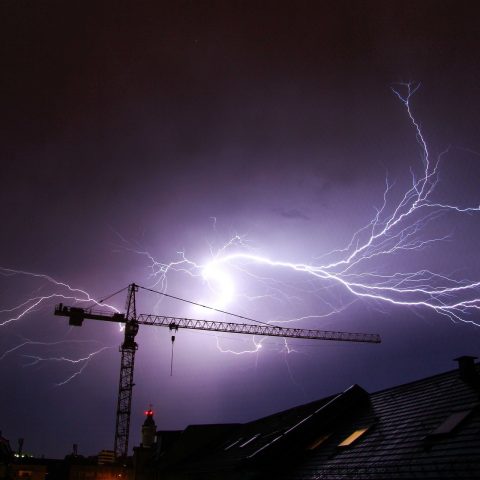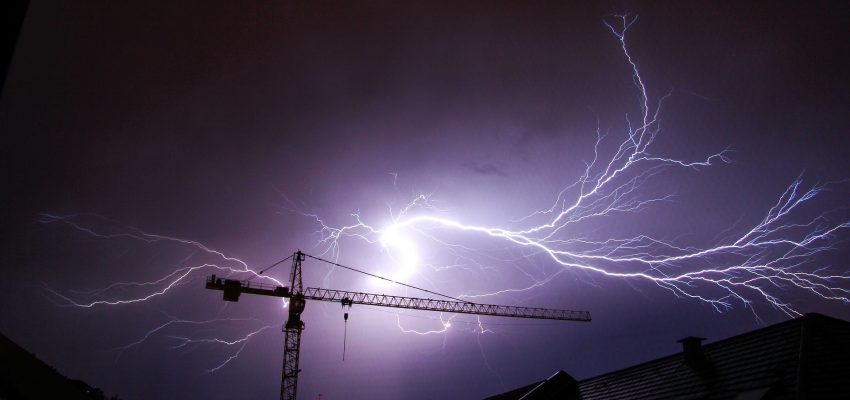This following is part of our telecom lightning protection series, which is based on our whitepaper “Earth Potential Rise in Public Spaces Near Telecommunications Facilities,” that was published in IEEE and presented at Intelec 2018. You can download the full whitepaper here.
Network densification is an emerging telecommunications trend that helps support the availability of high capacity and high-speed data to mobile users. While these networks will provide users with a better experience, there are several considerations that need to be accounted for when the telecommunications equipment is close to high voltage (HV) power assets.
Street mounted telecommunications will sometimes be placed near power utility assets like transformers, extra high voltage (EHV) towers and electrical substations. This proximity presents risks to the telecommunications facility. Exercising care in the location and earthing design of the facility can help mitigate these risks.
For a telecom facility placed near electrical transformers or other power utility assets, review these six scenarios that require extra care in order to alleviate safety, cost and liability concerns.
Scenario 1: Power Utility Pole with a Low Voltage Transformer
This scenario involves telecommunication equipment (e.g. small cells) being installed on a power utility pole where a low voltage transformer is also installed.

Dangerous voltage can appear near or inside telecom equipment, meaning the full prospective transformer fault current can be injected into common earth electrodes. The resulting voltages can appear inside the telecom equipment. This installation method should not be permitted.
Scenario 2: Power Utility Pole with Transformer Nearby
This scenario, which may seem to have lower risk to Scenario 1, also requires additional attention. If telecom equipment is mounted on a power utility pole that has a transformer on the preceding pole, there is still potential for EPR, step voltage and touch voltages from the transformer to appear at the telecommunications facility.

The typical distance between power poles is 40 meters. Modelling should be conducted to ensure that EPR, step voltages and touch voltages caused by the power system are at tolerable levels at the telecommunication facility location.
Scenario 3: Pad Mount Transfer At One End of a Building
Consider an example with the following circumstances:
- Pad mount transformer installed at one end of a building
- Steel columns from earth to roof
- Sheet-steel roofing material
- Radio site made of steel clad sandwich panel at the opposite end
- Metallic cable tray and wire connects shelter to building roof electrically
- Antennas on the rooftop

Adequate distance between the pad-mounted transformer and the radio site is the first concern, as a dangerous EPR situation could exist. Additional issues can ensue from the steel frame building transferring voltage from the transformer to the earth system of the radio site. This potential can also transfer to the steel frame supporting the antenna.
Exercise care to allow adequate separation to minimize EPR and transferred voltages. A well-designed earthing system and appropriate settings on the circuit breakers within the transformer help prevent prolonged dangerous voltages from developing.
Scenario 4: Pad-Mounted Transformer Near a Telecom Street Cabinet
For this scenario involving a pad-mounted transformer installed near a telecom street cabinet. Assume the transformer and telecom housing are similarly sized. The street cabinet has two to three earth electrodes that are 1.8 meters long and in a row spaced two meters apart. The transformer has a ring earth electrode with vertical electrodes at each corner.

At close distances, the EPR, step voltages and touch voltages arising from AC-power faults at the transformer, can be intolerable at the telecommunications equipment. A 30 to 40 meter distance is likely to be safe. If installation must be closer, additional design or modelling must be undertaken to ensure safe voltages at the telecommunications cabinets.
Download the whitepaper, “Earth Potential Rise in Public Spaces Near Telecommunications Facilities,” to find out what to do in each of these scenarios.
Scenario 5: Telecom Shelter or Cabinet Near Transmission Tower
Specifically, this scenario involves a telecommunications shelter or cabinet placed near the base of an EHV transmission tower where the antenna is mounted on the tower.

Fortunately, the phase to earth faults on these EHV transmission towers are extremely rare and typically of short duration. Design still requires thoughtful attention and testing to minimize expected EPR, touch and step voltages.
Scenario 6: Telecom Shelter By a Large EHV Switchyard
Though the telecommunication tower is some distance from the substation zone in this scenario, touch and step voltages exist around the tower. Careful design and modelling must be carried out to keep EPR, touch and step voltages within a permissible range.
Learn More About How to Solve Telecom Lightning Problems
The problems and solutions presented above are high-level examples for limiting EPR in telecommunication installations. The nVent ERICO and IEEE whitepaper titled, “Earth Potential Rise in Public Spaces Near Telecommunications Facilities” delves deeper into each situation to instruct best practices.


